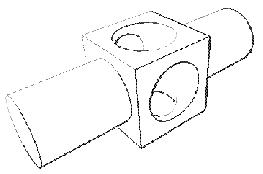
|
| Figure 2.6: Image from a frame of Markosian et al. [24] real-time 3D interactive system for illustrating non-self-intersecting polygon mesh-based models. Copyright 1997 Lee Markosian. Used by permission. |
The batch-oriented systems presented previously lack the ability for the user to interactively change the viewpoint. There are only a few systems which allow the user to manipulate the viewpoint and the environment.
The Sketch system developed by Zeleznik et al. [42] uses gestures to create and manipulate polygonal shapes, ``bridging the gap between hand sketches and computer-based modeling programs.'' The emphasis of their system is creating and editing polygonal objects. Driskill [12] explored illustrating exploded views of assembly with minimal user intervention through a 3D, interactive display. She listed some basic illustration rules as they apply to exploded views; however, she was less concerned with how the model appeared, since her emphasis was conveying relationships between parts.

|
| Figure 2.6: Image from a frame of Markosian et al. [24] real-time 3D interactive system for illustrating non-self-intersecting polygon mesh-based models. Copyright 1997 Lee Markosian. Used by permission. |
Markosian et al. [24] developed a real-time 3D interactive system for illustrating non-self-intersecting polygon mesh-based models, as seen in Figure 2.6. Their basic scheme is to use probabilistic identification of silhouette edges, interframe coherence of silhouette edges, and improvements and simplifications in Appel's hidden-line algorithm [1], a method based on the notion of quantitative invisibility which keeps track of front facing polygons dependent upon the camera's position. However, using randomized checks for silhouettes causes problems with frame-to-frame coherence as well as introducing the risk of missing new silhouettes. They also had to add some extra tests to deal with silhouettes that cusp. They view these possible silhouette misses as less important in a real-time system. Using techniques based on economy of line, they convey information with few strokes, displaying silhouette edges and certain user-chosen key features, such as creases. In addition, they added options for sketchy lines or hatched shading strokes. The end result is a 3D interactive environment, where a single frame looks like an artist's sketch. They achieved their real-time interaction by using the silhouette calculated in the previous frame to guess at which lines are to be shown in the next. Their methods are only applicable for polygonal models and do not convey material properties.